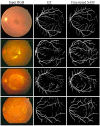Generalist Vision Foundation Models for Medical Imaging: A Case Study of Segment Anything Model on Zero-Shot Medical Segmentation
- PMID: 37296799
- PMCID: PMC10252742
- DOI: 10.3390/diagnostics13111947
Generalist Vision Foundation Models for Medical Imaging: A Case Study of Segment Anything Model on Zero-Shot Medical Segmentation
Abstract
Medical image analysis plays an important role in clinical diagnosis. In this paper, we examine the recent Segment Anything Model (SAM) on medical images, and report both quantitative and qualitative zero-shot segmentation results on nine medical image segmentation benchmarks, covering various imaging modalities, such as optical coherence tomography (OCT), magnetic resonance imaging (MRI), and computed tomography (CT), as well as different applications including dermatology, ophthalmology, and radiology. Those benchmarks are representative and commonly used in model development. Our experimental results indicate that while SAM presents remarkable segmentation performance on images from the general domain, its zero-shot segmentation ability remains restricted for out-of-distribution images, e.g., medical images. In addition, SAM exhibits inconsistent zero-shot segmentation performance across different unseen medical domains. For certain structured targets, e.g., blood vessels, the zero-shot segmentation of SAM completely failed. In contrast, a simple fine-tuning of it with a small amount of data could lead to remarkable improvement of the segmentation quality, showing the great potential and feasibility of using fine-tuned SAM to achieve accurate medical image segmentation for a precision diagnostics. Our study indicates the versatility of generalist vision foundation models on medical imaging, and their great potential to achieve desired performance through fine-turning and eventually address the challenges associated with accessing large and diverse medical datasets in support of clinical diagnostics.
Keywords: Segment Anything Model (SAM); deep Learning; foundation models; large AI models; medical image segmentation; zero-shot segmentation.
Conflict of interest statement
The authors declare no conflict of interest.
Figures




Similar articles
-
Segment anything model for medical image analysis: An experimental study.Med Image Anal. 2023 Oct;89:102918. doi: 10.1016/j.media.2023.102918. Epub 2023 Aug 2. Med Image Anal. 2023. PMID: 37595404 Free PMC article.
-
Segment Anything Model (SAM) for Digital Pathology: Assess Zero-shot Segmentation on Whole Slide Imaging.IS&T Int Symp Electron Imaging. 2025;37:COIMG-132. doi: 10.2352/EI.2025.37.14.COIMG-132. Epub 2025 Feb 1. IS&T Int Symp Electron Imaging. 2025. PMID: 40190816 Free PMC article.
-
ProtoSAM-3D: Interactive semantic segmentation in volumetric medical imaging via a Segment Anything Model and mask-level prototypes.Comput Med Imaging Graph. 2025 Apr;121:102501. doi: 10.1016/j.compmedimag.2025.102501. Epub 2025 Feb 1. Comput Med Imaging Graph. 2025. PMID: 39919534
-
A review of the Segment Anything Model (SAM) for medical image analysis: Accomplishments and perspectives.Comput Med Imaging Graph. 2025 Jan;119:102473. doi: 10.1016/j.compmedimag.2024.102473. Epub 2024 Dec 5. Comput Med Imaging Graph. 2025. PMID: 39673905 Review.
-
Artificial intelligence in medical imaging: From task-specific models to large-scale foundation models.Chin Med J (Engl). 2025 Mar 20;138(6):651-663. doi: 10.1097/CM9.0000000000003489. Epub 2025 Feb 26. Chin Med J (Engl). 2025. PMID: 40008785 Free PMC article. Review.
Cited by
-
Improved Generalizability in Medical Computer Vision: Hyperbolic Deep Learning in Multi-Modality Neuroimaging.J Imaging. 2024 Dec 12;10(12):319. doi: 10.3390/jimaging10120319. J Imaging. 2024. PMID: 39728216 Free PMC article.
-
MRI radiomics-based decision support tool for a personalized classification of cervical disc degeneration: a two-center study.Front Physiol. 2024 Jan 3;14:1281506. doi: 10.3389/fphys.2023.1281506. eCollection 2023. Front Physiol. 2024. PMID: 38235385 Free PMC article.
-
Technical note: Generalizable and promptable artificial intelligence model to augment clinical delineation in radiation oncology.Med Phys. 2024 Mar;51(3):2187-2199. doi: 10.1002/mp.16965. Epub 2024 Feb 6. Med Phys. 2024. PMID: 38319676 Free PMC article.
-
Enhancing Meibography Image Analysis Through Artificial Intelligence-Driven Quantification and Standardization for Dry Eye Research.Transl Vis Sci Technol. 2024 Jun 3;13(6):16. doi: 10.1167/tvst.13.6.16. Transl Vis Sci Technol. 2024. PMID: 38904611 Free PMC article.
-
Enhancing Microdroplet Image Analysis with Deep Learning.Micromachines (Basel). 2023 Oct 22;14(10):1964. doi: 10.3390/mi14101964. Micromachines (Basel). 2023. PMID: 37893401 Free PMC article.
References
-
- Bommasani R., Hudson D.A., Adeli E., Altman R., Arora S., von Arx S., Bernstein M.S., Bohg J., Bosselut A., Brunskill E., et al. On the opportunities and risks of foundation models. arXiv. 20212108.07258
-
- Mattjie C., de Moura L.V., Ravazio R.C., Kupssinskü L.S., Parraga O., Delucis M.M., Barros R.C. Exploring the zero-shot capabilities of the segment anything model (sam) in 2d medical imaging: A comprehensive evaluation and practical guideline. arXiv. 20232305.00109
-
- Qiu J., Li L., Sun J., Peng J., Shi P., Zhang R., Dong Y., Lam K., Lo F.P.W., Xiao B., et al. Large AI Models in Health Informatics: Applications, Challenges, and the Future. arXiv. 20232303.11568 - PubMed
-
- Kirillov A., Mintun E., Ravi N., Mao H., Rolland C., Gustafson L., Xiao T., Whitehead S., Berg A.C., Lo W.Y., et al. Segment Anything. arXiv. 20232304.02643
-
- Deng R., Cui C., Liu Q., Yao T., Remedios L.W., Bao S., Landman B.A., Wheless L.E., Coburn L.A., Wilson K.T., et al. Segment Anything Model (SAM) for Digital Pathology: Assess Zero-shot Segmentation on Whole Slide Imaging. arXiv. 20232304.04155
Grants and funding
LinkOut - more resources
Full Text Sources

